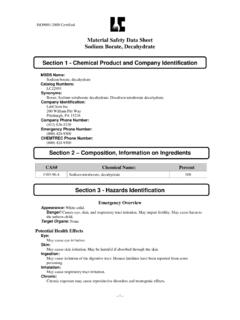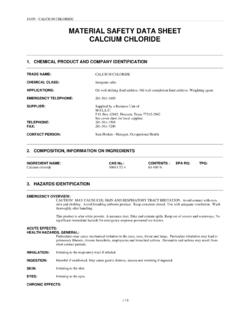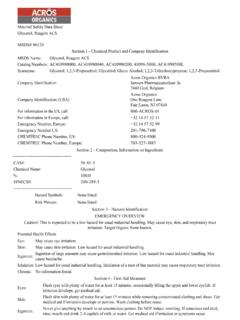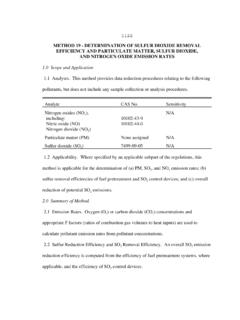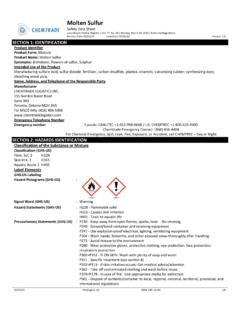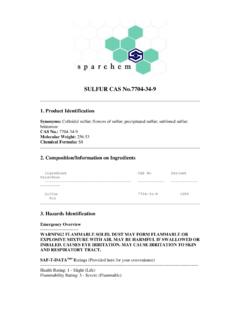Transcription of 1794 Sulfur Rev 2006 - westliberty.edu
1 MATERIAL SAFETY DATA SHEET Sulfur MSDS No. 1794 Revision Date: 7/1/2006 Page 1 of 8 EMERGENCY OVERVIEW DANGER! FLAMMABLE SOLID - BURNING Sulfur EMITS TOXIC AND SUFFOCATING Sulfur DIOXIDE - MOLTEN Sulfur MAY EVOLVE TOXIC AND FLAMMABLE HYDROGEN SULFIDE GAS - MOLTEN Sulfur CAN CAUSE THERMAL BURNS Solid and molten Sulfur can be ignited; burning Sulfur produces Sulfur dioxide, an irritating, toxic, and suffocating gas. Dust particles may be irritating to the eyes, nose, throat, and skin.
2 Molten Sulfur can cause thermal burns. Molten Sulfur may evolve HYDROGEN SULFIDE (toxic gas) which may accumulate in storage container vapor space. High concentration may cause immediate unconsciousness - death may result unless victim is promptly and successfully resuscitated. Hydrogen sulfide causes eye irritation. NFPA 704 (Section 16) 1. CHEMICAL PRODUCT AND COMPANY INFORMATION HOVENSA LLC 1 Estate Hope Christiansted, VI 00820-5652 EMERGENCY TELEPHONE NUMBER (24 hrs): CHEMTREC (800)424-9300 COMPANY CONTACT (business hours): (340) 692-3000 SYNONYMS: Brimstone; Sulphur See Section 16 for abbreviations and acronyms.
3 2. COMPOSITION and CHEMICAL INFORMATION ON INGREDIENTS INGREDIENT NAME (CAS No.) CONCENTRATION PERCENT BY WEIGHT Sulfur (7704-34-9) 100 Hydrogen Sulfide (7783-06-4) < trace - see below > Hydrogen Sulfide (H2S) may be present in trace quantities (by weight) in molten Sulfur but may accumulate to toxic or flammable concentrations in enclosed spaces such as molten Sulfur storage pits, tanks, or tanker/railcar headspaces. H2S is not considered a hazard associated with solid Sulfur . 3. HAZARDS IDENTIFICATION EYES Contact with molten Sulfur may cause serious burns and blindness.
4 Sulfur vapor may cause eye irritation. Dust contact with eyes may cause mechanical irritation (abrasion), characterized by a scratchy discomfort. This may progress to burning and tearing, with blurring of vision upon repeated or prolonged exposure. These symptoms are generally reversible once exposure is discontinued. Excessive exposure may cause more severe symptoms such as redness, pain, sensitivity to light, and conjunctivitis. Some severe exposure cases have resulted in permanent damage. Exposure to approximately 8 ppm Sulfur vapor has been shown to cause eye irritation.
5 MATERIAL SAFETY DATA SHEET Sulfur MSDS No. 1794 Revision Date: 7/1/2006 Page 2 of 8 SKIN Prolonged contact with Sulfur dust in a localized area may result in irritation, primarily from abrasive action. Molten Sulfur may cause 1st, 2nd, or 3rd degree thermal burns. INGESTION Ingestion of small amounts of solid Sulfur should not cause significant health effects. Large does can produce mucous membrane irritation, difficult swallowing, redness of the throat and tongue, stomach, and urinary disturbances.
6 Vomiting, abdominal pain and diarrhea may also occur. Long-term ingestion of small amounts may have a laxative effect. Ingestion of very large amounts may cause sore throat, nausea, headache, and possibly unconsciousness in severe cases. May be converted into hydrogen sulfide in the intestine. INHALATION Inhalation of low concentrations of dust should not cause significant health effects. Inhalation of large amounts of dust may cause inflammation of the nose and throat, resulting in secretions from the nose. Symptoms include sore throat, tightness of the chest, chest pain, lightheadedness, and persistent cough with sputum.
7 WARNING: Irritating and toxic hydrogen sulfide gas may be found in confined vapor spaces. Greater than 15 - 20 ppm continuous exposure can cause mucous membrane and respiratory tract irritation. 50 - 500 ppm can cause headache, nausea, and dizziness, loss of reasoning and balance, difficulty in breathing, fluid in the lungs, and possible loss of consciousness. Greater than 500 ppm can cause rapid or immediate unconsciousness due to respiratory paralysis and death by suffocation unless the victim is removed from exposure and successfully resuscitated.
8 The "rotten egg" odor of hydrogen sulfide is not a reliable indicator for warning of exposure, since olfactory fatigue (loss of smell) readily occurs, especially at concentrations above 50 ppm. At high concentrations, the victim may not even recognize the odor before becoming unconscious. CHRONIC Long-term exposure to high concentrations can cause respiratory disease - see Section 11, Toxicological Information. MEDICAL CONDITIONS AGGRAVATED BY EXPOSURE Exposure may aggravate preexisting bronchitis, asthma, and open wounds, skin disorders, and dermatitis (rash).
9 4. FIRST AID MEASURES EYES In case of contact with eyes, immediately flush with clean, low-pressure water for at least 15 min. Hold eyelids open to ensure adequate flushing. Seek medical attention. SKIN Remove contaminated clothing. Wash contaminated areas thoroughly with soap and water or waterless hand cleanser. Obtain medical attention if irritation or redness develops. Thermal burns require immediate medical attention depending on the severity and the area of the body burned. INGESTION DO NOT INDUCE VOMITING. Do not give liquids.
10 Obtain immediate medical attention. If spontaneous vomiting occurs, lean victim forward to reduce the risk of aspiration. Monitor for breathing difficulties. Small amounts of material which enter the mouth should be rinsed out until the taste is dissipated. INHALATION Remove person to fresh air. If person is not breathing provide artificial respiration. If necessary, provide additional oxygen once breathing is restored if trained to do so. Seek medical attention immediately. MATERIAL SAFETY DATA SHEET Sulfur MSDS No.
